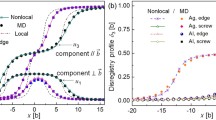Abstract
Using embedded atom method and molecular static relaxation method, the core structure of 〈100〉, 〈110〉 edge dislocations, 〈100〉 screw dislocation, the interaction between point defects and 〈100〉 edge dislocation in NiAl intermetallics were investigated. The results show that 〈100〉 edge dislocation expands along [110] and \([\bar 111]\) orientation on the (001) slip plane. The core structure of 〈100〉 edge dislocation on (001) plane is like a ”butterfly”, while it is very compact when it lies on {110} slip plane. So NiAl will have a 〈100〉 {110} slip system in stead of 〈100〉 {100} slip system, as experiments showed. 〈110〉 edge dislocation has a more expanded core structure and the atoms of dislocation core distort more heavily. None dislocation dissociation was found in the studied dislocations. The outlines of dislocation core structures change very little after a row of point defects are introduced in them, which can be explained by point defects’ little effects on the stress field around dislocation core. The results also show that it is hard to change dislocation core structure by decreasing alloy order using the method of introducing limited point defects into the alloy.
Similar content being viewed by others
References
Mills M J, Mirocle D B. The structure of a 〈100〉 and a 〈110〉 dislocation cores in NiAl. Acta Metall Mater, 1993,41:85–95
Nagpal P, Baker I. TEM in-situ straining of NiAl. Intermetallics, 1994,2:23–28
Miracle D B, Russell S, Law C C. Slip system modification in NiAl. In: High Temperature Ordered Intermetallic Alloys V. Liu C T et al eds. Pittsburgh, PA, USA, 1995,364:225–229
Crimp M A, Tonn DC, Zhang Y. Dislocation core structures in B2 NiAl alloys. Materials Science and Engineering, 1993,A170:95–102
Mills M J, Daw M S, Foiles S M, et al. HRTEM observation and EAM calculation of dislocation cores in NiAl. In: High Temperature Ordered Intermetallic Alloys V. Liu C T et al eds. Pittsburgh, PA, USA, 1993,288:257–261
Vailhe C, Farkas D. Trends in dislocation core structures and mechanical behavior in B2 aluminides. In: High Temperature Ordered Intermetallic Alloys VI. Pope D P et al eds. Pittsburgh, PA, USA, 1995,364:389–392
Foiles S M, Baskes M I, Daw M S. Embedded-atom-method functions for the fcc metals Cu, Ag, Au, Ni, Pd, Pt, and their alloys. Physical Review B, 1986,33:7983–7989
Daw M S, Baskes M I. Embedded-atom-method: Derivation and application to impurities, surfaces, and other defects in metals. Physical Review B, 1984,29:6443–6452
Liu Zhenyun, Lin Dongliang, Chen Da. Atomistic simulation of point defects in NiAl alloy. Trans Nonferrous Met Soc China, 1997,7(2):128–131
Liu Zhenyun, Lin Dongliang, Huang Baiyun. Simulation of grain boundary in NiAl alloy. Trans Nonferrous Met Soc China, 1999,9(1):105
Vitek V. Structure of dislocation cores in metallic materials and its impact on their plastic behavior. Progress in Materials Science, 1992,36:1–14
Noebe R D, Bowman R R, Nathal M V. Physical and mechanical properties of the B2 compound NiAl. International Materials Reviews, 1993,38:193–234
Author information
Authors and Affiliations
Additional information
Project supported by the National Natural Science Foundation of China
Synopsis of the first author Liiu Zhenyun, born in 1972, received PhD degree in November 1996, major research fields: electron microscopy, high temperature ordered intermetallics and automotive friction materials.
Rights and permissions
About this article
Cite this article
Liu, Z., Huang, B. & Lin, D. Computer simulation of dislocation cores in B2 NiAl intermetallics. J Cent. South Univ. Technol. 6, 4–7 (1999). https://doi.org/10.1007/s11771-999-0020-8
Received:
Issue Date:
DOI: https://doi.org/10.1007/s11771-999-0020-8




